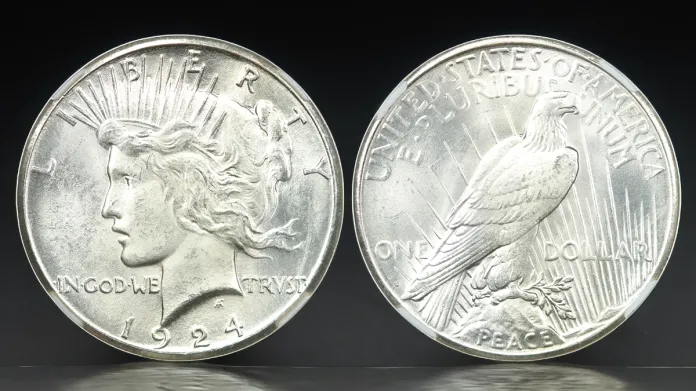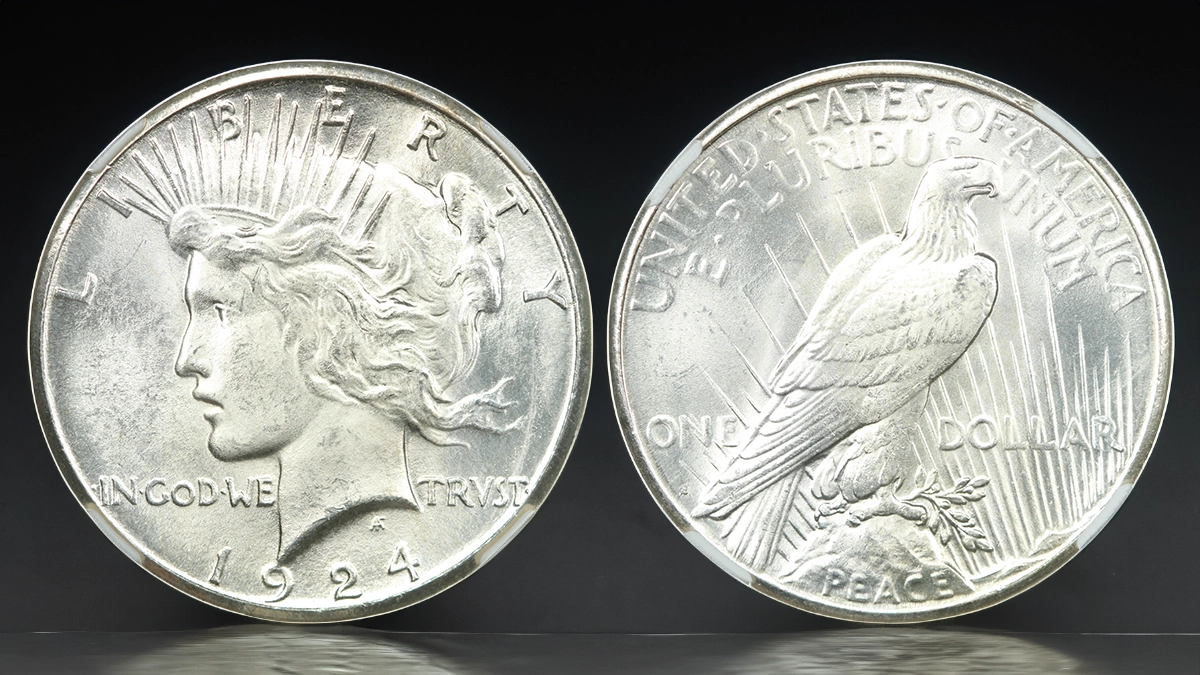
By Charles Morgan and Hubert Walker for CoinWeek Notes …..
1924 marked the fourth year of production of Anthony de Francisci’s Peace Dollar design. As a denomination, the silver dollar had limited appeal as a circulating medium, seeing most of its use in the western states. Under the terms of the Pittman Act of 1918, however, hundreds of millions of Morgan Dollars held by the United States Treasury were melted and sold to United Kingdom and then re-coined as Indian Rupees.
A key provision of the Act required that the Federal Government repurchase the silver it had sold (a concession to western mining interests) and then re-coin silver dollars. This recoinage began in 1921 with newly created hubs of the Morgan type, before public input pressured the Treasury to introduce a new coin design to commemorate the end of the First World War.
As silver dollar production commenced in 1924, the United States Mint had already produced over 200 million of the 270 million silver dollars from the Congressional mandate. Starting this year, production would noticeably slow. Philadelphia reduced its output by 2/3, striking 11,811,000 1924 Peace Dollars, while the San Francisco Mint reduced its output by 90%. The Denver Mint did not strike silver dollars.
The 1924-S Peace Dollar mintage of 1,728,000 pieces makes the coin a series semi-key. For collectors of Mint State examples, the 1924-S gets increasingly scarce as one approaches the Gem Mint grade of MS65. MS66 examples are rare.
* * *
1924-S Peace Dollar Historic Pricing Data
The 1924-S Peace Dollar was represented in the Redfield Hoard.
In the January 1976 Numismatist, John B. Love of the Record Coin Shop in Cut Bank, Montana, advertised that he was offering $1,600 for nice BU Rolls of this date.
In the August 1976 Numismatist, dealer Joel Rettew advertised that he was selling Gem BU examples of the 1924-S Peace Dollar from the Redfield Hoard for $165 each.
In an August 1978 Numismatist ad, dealer George H. Ashley, Jr. of Capital City Coin Exchange in Richmond, Virginia, advertised GEM BU 1921 Peace dollars for sale at $220 each.
Market Data and Noteworthy Specimens
Top Population: PCGS MS66 (6, 11/2024), NGC MS66 (2, 11/2024), and CAC MS66 (2:1 stickered:graded, 11/2024).
- PCGS MS66 #34728683: PCGS User z20014. Imaged on PCGS CoinFacts. Brilliant.
- NGC MS66 #4196792-003: (Possibly) Heritage Auctions, January 6, 1999, Lot 5234 – $16,387.50; “The Pittstown Collection,” Stack’s Bowers, March 25, 2021, Lot 4133 – $28,800.
- PCGS MS66 CAC #6569223: “The Paul Taylor Collection,” Heritage Auctions, April 28, 2011, Lot 5301 – $54,625.
* * *
Design
Obverse:
A left-facing bust of a younger Liberty wears a tiara of rays that resembles the radiant crown on the Statue of Liberty. Most of Liberty’s hair is in a bun at the back of her head, though several locks are loose and hanging alongside her neck.
Arcing clockwise along the rim on the upper half of the obverse field is the inscription LIBERTY, and centered below the bust of Liberty near the bottom rim is the date 1924. The motto IN GOD WE TRUST appears in a single line of text across the lower quarter of the obverse. It spreads across that section of the field, with the words IN GOD WE appearing to the left of Liberty and the word TRUST located behind her neck. Dots appear between the words IN GOD WE and are also seen on the rim side of the words IN and TRUST. The designer’s monogram, AF, appears below Liberty’s neck in the lower obverse field.
Reverse:
The reverse features an American bald eagle perched on a mountaintop. Clutched in its claws is an olive branch symbolizing peace; not included in this particular depiction of the eagle is a band of arrows representing military strength, a symbol commonly seen in most portrayals of the patriotic bird. The rightward-facing eagle is seen at an angle partly turned away from the viewer and towards a sunrise, which symbolizes the promise of dawning peace in the world.
The bold rays in the image of the rising sun harmonize with the rays seen in Liberty’s tiara on the coin’s obverse. The legend UNITED STATES oF AMERICA appears along the rim in the top half of the reverse. The motto E PLURIBUS UNUM is located directly below in lettering identical in size to the legend. The eagle’s beak breaks the bottom of the “S” in PLURIBUS and visually divides that word from UNUM; a dot punctuates the space between E and PLURIBUS.
The denomination ONE DOLLAR appears across the bottom third of the reverse in a single line of text, with the word ONE inscribed to the left of the eagle by its tail feathers and DOLLAR superimposed over the sun’s rays to the right of the eagle. Beneath the word ONE is the S mintmark of the San Francisco Mint. PEACE is inscribed along the rim below the eagle, atop the rock on which the patriotic bird stands.
Edge:
The edge of the 1924-S Peace Dollar is reeded.
Designer
Anthony de Francisci was born in Palermo, Sicily in 1887 and emigrated to the United States in 1905. He began his career as a sculptor studying under such notable numismatic artists as James Earle Fraser, Hermon Atkins MacNeil, and Adolph Weinman. The Peace Dollar (1921-35) is his most famous creation but he also produced several medals. He died in 1964.
1924-S Peace Dollar Coin Specifications
| Country: | United States of America |
| Year of Issue: | 1924 |
| Denomination: | One Dollar (USD) |
| Mintmark: | S (San Francisco) |
| Mintage: | 1,728,000 |
| Alloy: | .900 Silver, .100 copper |
| Weight: | 26.73 g |
| Diameter: | 38.10 mm |
| Edge: | Reeded |
| OBV Designer: | Anthony de Francisci |
| REV Designer: | Anthony de Francisci |
| Quality: | Business Strike |


